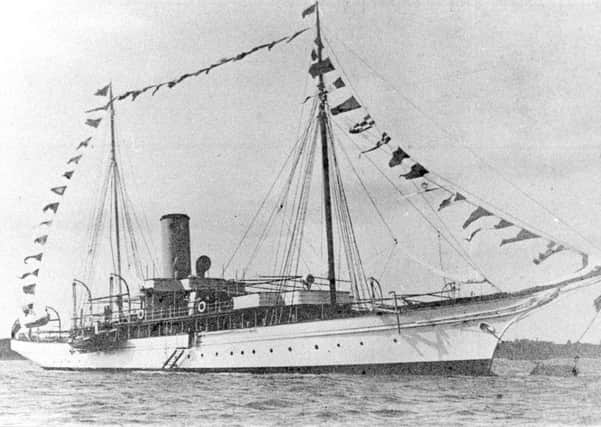Scotsman 200: Tragic loss of the Iolaire


Thursday 2 January 1919
Wreck at Stornoway: Reported loss of 270 lives
A disaster which has cast a gloom over Stornoway and Lewis took place early yesterday morning, when the steam yacht Iolaire, with 300 sailors from Kyle of Lochalsh to Stornoway – these men were all on New Year holiday leave – struck the Beasts of Holm, dangerous, jagged rocks situated to the right of Stornoway harbour entrance.
Of the 300 on board only about 30 were reported saved. They scrambled ashore as best they could, some of them very seriously injured, some making marvellous escapes. All the officers and most of the crew of the Iolaire were lost.
Advertisement
Hide AdThe ship, which was in the charge of Commander Mason, left Kyle about 8pm, an hour ahead of the Sheila. She had an excellent passage across the Minch, with a fair wind from the south freshening as the voyage proceeded.
Between 1am and 2am she was approaching Stornoway Harbour, the lights on Arnish Point and the beacon off the harbour entrance being quite visible. The passengers were in high spirits, eagerly anticipating their New Year holiday, the first since hostilities ceased. For some reason quite inexplicable the vessel, instead of turning into Stornoway Harbour, proceeded right across the harbour mouth, and ran ashore at full speed near Holm Head. By this time the wind had increased and there was a high sea running on the leeshore, where the Iolaire had struck.
Some narratives have been gleaned from survivors, who unfortunately are few. Accurate figures are not available but the number is put variously at 35 to 50, so that the loss is over 200 men.
A young Naval Reservist, interviewed by our correspondent, said: “It was very dark, there being no moon, but the atmosphere was clear, and lights were distinctly visible at a great distance. As we were approaching Arnish Lighthouse we commenced getting our kit together, expecting to be safely alongside Stornoway Pier in a few minutes.
“It was about ten minutes to two, and I was in the salon when there came a great crash, and the vessel heeled heavily to starboard. It was so dark that we could not see the land, which was only 30 yards distant from the point we struck. I didn’t think it was rock we struck, but just that we ran ashore. When the ship listed the seas came breaking over, and I should say 40 or 50 men jumped overboard. I think every one of them was drowned. There was a great panic on board.
“Two lifeboats were launched, and both were swamped. From the first, one man scrambled back on board. With this exception I think all the men who went into the boats were drowned. When the Iolaire struck she was bow on to the land, but about ten minutes afterwards she lifted and drove a little to seawards, afterwards coming in stern first, and falling broadside on to the shore. Rockets were fired, and by their light I could see that her stern was now not more then seven yards from a ledge of rocks jutting out from the shore, and amidships she was within twenty yards of the only available place for landing. The seas were breaking over the stern, but many were tempted to try to reach the rocks there which were so near. I don’t think any of them succeeded, for there was a very strong current running between the ship’s stern and the ledge of the rocks, and I believe there were scores of men dashed to death against the rocks.
Advertisement
Hide Ad“When the second or third rocket went up I observed a line hanging into the sea from one of the davits amidships, and as the vessel, broadside on, was breaking the force of the sea on the shore at this part I let myself down by the line, got hold of a bit of wreckage, and tried to make the shore. However I got entangled in the ropes hanging from one of the boats that had been swamped. I managed to get clear and finally reached the shore. As far as I know I was the first man to reach land.
“All the men who were saved scrambled shore by the aid of this rope. Ultimately the Iolaire fell off to port, and the hawser snapped. I was very exhausted and dazed, and wandered about for an hour or two before I found a farmhouse, where all of us who got ashore were hospitably received.”
Advertisement
Hide AdAfter the hull of the Iolaire disappeared one plucky lad, Donald Morrison of 7 Knockard, continued to hang on to the mast. It was impossible to render assistance from the sea owing to the position of the wreck. When the storm subsided Morrison was taken off in a very exhausted condition, after being eight hours clinging in his precarious perch.
A list of the men lost can only be compiled by degrees as their names become known through their relatives, who are scattered throughout the hundred villages of Lewis. A complete list of the saved is also at present unavailable. So far, only 24 bodies have been recovered, but it is expected that a large number will come ashore on the next tide.
Saturday 4 January 1919
It is one of the saddest incidents of the war, and hardened as the nation may have become during the past four years to death and destruction on an unprecedented scale, people cannot read the story of the Stornoway disaster as it has been unfolded in its pathetic circumstances without a feeling of peculiar poignancy and sympathy. The calamity has plunged the whole island into grief; almost every township has been stricken.
The full text of this edited extract can be found at The Scotsman Digital Archive